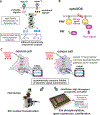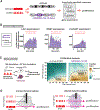Cancer mutations and targeted drugs can disrupt dynamic signal encoding by the Ras-Erk pathway
- PMID: 30166458
- PMCID: PMC6430110
- DOI: 10.1126/science.aao3048
Cancer mutations and targeted drugs can disrupt dynamic signal encoding by the Ras-Erk pathway
Abstract
The Ras-Erk (extracellular signal-regulated kinase) pathway encodes information in its dynamics; the duration and frequency of Erk activity can specify distinct cell fates. To enable dynamic encoding, temporal information must be accurately transmitted from the plasma membrane to the nucleus. We used optogenetic profiling to show that both oncogenic B-Raf mutations and B-Raf inhibitors can cause corruption of this transmission, so that short pulses of input Ras activity are distorted into abnormally long Erk outputs. These changes can reshape downstream transcription and cell fates, resulting in improper decisions to proliferate. These findings illustrate how altered dynamic signal transmission properties, and not just constitutively increased signaling, can contribute to cell proliferation and perhaps cancer, and how optogenetic profiling can dissect mechanisms of signaling dysfunction in disease.
Copyright © 2018 The Authors, some rights reserved; exclusive licensee American Association for the Advancement of Science. No claim to original U.S. Government Works.
Conflict of interest statement
Figures




Comment in
-
From oncogenic mutation to dynamic code.Science. 2018 Aug 31;361(6405):844-845. doi: 10.1126/science.aau8059. Science. 2018. PMID: 30166473 No abstract available.
-
Lighting Up Cancer Dynamics.Trends Cancer. 2018 Oct;4(10):657-659. doi: 10.1016/j.trecan.2018.06.001. Epub 2018 Sep 25. Trends Cancer. 2018. PMID: 30292348
References
-
- Shaul YD, Seger R, The MEK/ERK cascade: From signaling specificity to diverse functions. Biochim. Biophys. Acta 1773, 1213–1226 (2007). - PubMed
Publication types
MeSH terms
Substances
Grants and funding
LinkOut - more resources
Full Text Sources
Other Literature Sources
Medical
Research Materials
Miscellaneous

